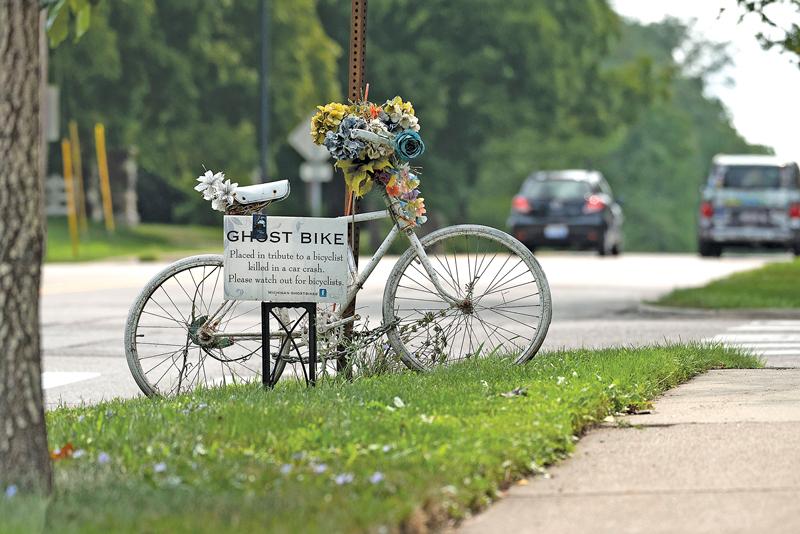“It doesn’t matter if you’re the best biker in the world,” adds Kralovich, medical director of St. Joe’s trauma center. “It’s the car. You’re still at risk for an accident that could be life ending or life altering and permanently debilitating.”
Five years ago, Kralovich says, St. Joe’s admitted about a dozen people a year for serious cycling-related injuries. They admitted twice that many in 2016, and twenty-seven last year.
Since 2014, four bicyclists have died in accidents in Ann Arbor. The latest was eighty-eight-year-old retired engineer Jing Xiang Shen. Riding north on Nixon Rd. on January 13, 2017, he was struck by a slow-moving SUV exiting a parking lot. He died three days later.
No one’s died in town so far this year, but on June 13, Ann Arborite Joshua Stockwell, a thirty-eight-year-old Marine Corps vet, was struck and killed on Pontiac Tr. in Ann Arbor Township.
“I heard of Stockwell’s death [with] numbness and frustration,” says Erica Briggs, chair of the Washtenaw Biking and Walking Coalition. Briggs has been riding all her life and never been hit but says she’s “known a few who have.”
Doug Tidd, the chair of the Ann Arbor Bicycle Touring Society, knows many who have. “A biker on Dexter-Pinckney Road got hit by an F-150. He had a stick in his chest and fractured his pelvis.”
Statistics from the Michigan State Police show the number of cycling crashes statewide increased 64 percent in the past decade. Considering how many more people are biking, that’s not surprising. According to the American Community Survey, the number of biking commuters doubled locally between 2006 and 2016, to 5.5 percent. That’s 3,129 trips daily, plus many more recreational riders.
U-M assistant professor of emergency medicine Brad Uren says he’s seeing only “a slight increase” in crashes during his emergency room shifts. “Mostly we see orthopedic stuff, broken bones, and lots of road rashes–the injuries you get when you’re knocked off your bike.
“Head injuries are the most devastating,” continues Uren. “Most of our cyclists in Ann Arbor are wearing helmets. But we get lot of trauma transfer from other parts of state where helmeting isn’t part of culture.”
To Kralovich’s surprise, St. Joe’s is seeing a lot more older riders. “Ten years ago, the average age of the injured bicyclists we saw was forty,” he says. “The average now is in the sixties.”
Some of those older riders are on bikes because they’ve lost their driver’s licenses, often for drunk driving. “There’re a significant number of injuries that are linked to bicyclists who have been drinking,” says Kralovich.
His advice: “Don’t drink and pedal … That’s likely to be our new emphasis, looking into judicial and rehabilitation for [bicycle safety] education. That may be our biggest chance to intervene.”
Pete Houk, previous chair of the Washtenaw Biking and Walking Coalition, says what Ann Arbor needs is “a network that supports safe routes wherever you’re trying to go.” He also favors lower speed limits. “I can only think of a few places [in the city] that something other than 25 mph works.”
Meanwhile, Houk takes steps to protect himself: he showed up for an interview wearing a helmet and a bright red jacket and riding on a Schwinn with lights fore and aft.
“Lights help,” says Tidd. “I see a lot of people driving in less than optimal conditions without a front or a back light and they’ve got dark clothes on.”
“Lack of visibility is a prime cause of accidents,” Kralovich concurs. “There are very few in morning, the number rises during day, and peaks at dusk.” And, he says,”folks should absolutely wear a helmet and it absolutely would make a difference.”
In June, Governor Snyder signed a bill that requires motorists to give at least three feet of space when passing cyclists, and puts a greater emphasis on bicycle safety in driver’s ed classes. Though watered down–the original proposal required five feet of clearance, and increased penalties for texting and driving causing a death–“this bill is better than no bill,” says Tidd. “And since it was signed it seems people are paying more attention [and] giving us more room.”
“The education component is huge,” Briggs adds. “Anything that can stop distracted driving is good. It seems most of the time, the drivers don’t know the bike is there.”



I was saddened to read the September Inside Ann Arbor article “Bicycle Injuries”. Many of these injuries and deaths would be prevented if bicyclists rode on the sidewalks, especially where and when the sidewalks are empty. Bicyclists are concerned regarding their safety at corners where drivers are not expecting a bicycle rider to be crossing in front of them. Their safety can be assured if the bicyclists stop at crosswalks and check for oncoming traffic as they would if they were pedestrians. Bicyclists are allowed to ride on the sidewalks in Ann Arbor even where pedestrians are present (www.a2gov.org/departments/systems-planning/planning-areas/transportation/Pages/Biking.aspx).